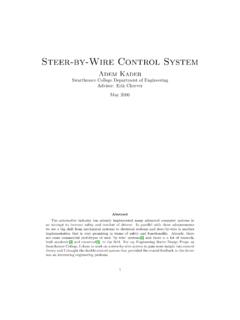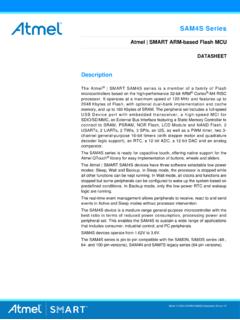Transcription of ATmega32A - Microchip Technology
1 ATmega32A . megaAVR Data Sheet Introduction The ATmega32A is a low power, CMOS 8-bit microcontrollers based on the AVR enhanced RISC archi- tecture. The ATmega32A is a 40/44-pins device with 32 KB Flash, 2 KB SRAM and 1 KB EEPROM. By exe- cuting instructions in a single clock cycle, the devices achieve CPU throughput approaching one million instructions per second (MIPS) per megahertz, allowing the system designer to optimize power consump- tion versus processing speed. Features High-performance, Low-power AVR 8-bit Microcontroller Advanced RISC Architecture 131 Powerful Instructions Most Single-clock Cycle Execution 32 8 General Purpose Working Registers Fully Static Operation Up to 16 MIPS Throughput at 16 MHz On-chip 2-cycle Multiplier High Endurance Non-volatile Memory segments 32 Kbytes of In-System Self-programmable Flash program memory 1024 Bytes EEPROM. 2 Kbytes Internal SRAM. Write/Erase Cycles: 10,000 Flash/100,000 EEPROM.
2 Data retention: 20 years at 85 C/100 years at 25 C(1). Optional Boot Code Section with Independent Lock Bits In-System Programming by On-chip Boot Program True Read-While-Write Operation Programming Lock for Software Security JTAG (IEEE std. Compliant) Interface Boundary-scan Capabilities According to the JTAG Standard Extensive On-chip Debug Support Programming of Flash, EEPROM, Fuses, and Lock Bits through the JTAG Interface QTouch Library Support Capacitive touch buttons, sliders and wheels QTouch and QMatrix acquisition Up to 64 sense channels 2018 Microchip Technology Inc. Data Sheet Complete DS40002072A-page 1. ATmega32A . Peripheral Features Two 8-bit Timer/Counters with Separate Prescalers and Compare Modes One 16-bit Timer/Counter with Separate Prescaler, Compare Mode, and Capture Mode Real Time Counter with Separate Oscillator Four PWM Channels 8-channel, 10-bit ADC. 8 Single-ended Channels 7 Differential Channels in TQFP Package Only 2 Differential Channels with Programmable Gain at 1x, 10x, or 200x Byte-oriented Two-wire Serial Interface Programmable Serial USART.
3 Master/Slave SPI Serial Interface Programmable Watchdog Timer with Separate On-chip Oscillator On-chip Analog Comparator Special Microcontroller Features Power-on Reset and Programmable Brown-out Detection Internal Calibrated RC Oscillator External and Internal Interrupt Sources Six Sleep Modes: Idle, ADC Noise Reduction, Power-save, Power-down, Standby and Extended Standby I/O and Packages 32 Programmable I/O Lines 40-pin PDIP, 44-lead TQFP, and 44-pad QFN/MLF. Operating Voltages - Speed Grades 0 - 16 MHz Power Consumption at 1 MHz, 3V, 25 C. Active: Idle Mode: Power-down Mode: < 1 A. 2018 Microchip Technology Inc. Data Sheet Complete DS40002072A-page 2. ATmega32A . Table of Contents 1 Pin Configurations .. 10. 2 Overview .. 11. Block Diagram .. 11. Pin 12. 3 Resources .. 13. 4 Data Retention .. 13. 5 About Code Examples .. 14. 6 Capacitive touch sensing .. 14. 7 AVR CPU Core .. 15. 15. ALU Arithmetic Logic 16. Status Register .. 16.
4 General Purpose Register File .. 17. Stack Pointer .. 19. Instruction Execution Timing .. 20. Reset and Interrupt 21. 8 AVR Memories .. 23. 23. In-System Reprogrammable Flash Program Memory .. 23. SRAM Data 24. EEPROM Data Memory .. 25. I/O 26. Register Description .. 27. 9 System Clock and Clock Options .. 31. Clock Systems and their Distribution .. 31. Clock Sources .. 32. Default Clock 32. Crystal Oscillator .. 32. Low-frequency Crystal Oscillator .. 34. External RC Oscillator .. 34. Calibrated Internal RC Oscillator .. 35. External Clock .. 36. 2018 Microchip Technology Inc. Data Sheet Complete DS40002072A-page 3. ATmega32A . Timer/Counter 37. Register Description .. 38. 10 Power Management and Sleep Modes .. 39. Sleep 39. Idle 39. ADC Noise Reduction 40. Power-down 40. Power-save 40. Standby Mode .. 40. Extended Standby Mode .. 41. Minimizing Power Consumption .. 41. Register Description .. 43. 11 System Control and Reset .. 44.
5 Resetting the AVR .. 44. Reset Sources .. 44. Internal Voltage 47. Watchdog Timer .. 48. Register Description .. 49. 12 Interrupts .. 51. Interrupt Vectors in ATmega32A .. 51. Register Description .. 54. 13 I/O Ports .. 56. 56. Ports as General Digital I/O .. 57. Alternate Port Functions .. 61. Register Description .. 70. 14 External Interrupts .. 73. Register Description .. 73. 15 8-bit Timer/Counter0 with PWM .. 76. Features .. 76. 76. Timer/Counter Clock Sources .. 77. Counter Unit .. 77. Output Compare 78. 2018 Microchip Technology Inc. Data Sheet Complete DS40002072A-page 4. ATmega32A . Compare Match Output Unit .. 79. Modes of Operation .. 80. Timer/Counter Timing Diagrams .. 84. Register Description .. 86. 16 Timer/Counter0 and Timer/Counter1 Prescalers .. 90. 90. Internal Clock Source .. 90. Prescaler Reset .. 90. External Clock Source .. 90. Register Description .. 92. 17 16-bit Timer/Counter1 .. 93. Features .. 93. 93. Accessing 16-bit Registers.
6 95. Timer/Counter Clock Sources .. 98. Counter Unit .. 98. Input Capture Unit .. 99. Compare Match Output Unit .. 103. Modes of Operation .. 104. Timer/Counter Timing Diagrams .. 111. Register Description .. 112. 18 8-bit Timer/Counter2 with PWM and Asynchronous Operation .. 119. Features .. 119. 119. Timer/Counter Clock Sources .. 120. Counter Unit .. 120. Output Compare 121. Compare Match Output Unit .. 123. Modes of Operation .. 123. Timer/Counter Timing Diagrams .. 127. Asynchronous Operation of the Timer/Counter .. 129. Timer/Counter Prescaler .. 131. Register Description .. 131. 19 SPI Serial Peripheral Interface .. 136. Features .. 136. 2018 Microchip Technology Inc. Data Sheet Complete DS40002072A-page 5. ATmega32A . 136. SS Pin Functionality .. 140. Data Modes .. 142. 20 USART .. 144. Features .. 144. 144. Clock Generation .. 146. Frame Formats .. 148. USART 149. Data Transmission The USART Transmitter .. 150. Data Reception The USART Receiver.
7 153. Asynchronous Data Reception .. 157. Multi-processor Communication Mode .. 160. Accessing UBRRH/UCSRC Registers .. 161. Register Description .. 163. Examples of Baud Rate 167. 21 Two-wire Serial Interface .. 172. Features .. 172. Two-wire Serial Interface Bus 172. Data Transfer and Frame Format .. 173. Multi-master Bus Systems, Arbitration and Synchronization .. 175. Overview of the TWI Module .. 177. Using the 179. Transmission Modes .. 181. Multi-master Systems and 192. Register Description .. 195. 22 Analog Comparator .. 198. 198. Analog Comparator Multiplexed Input .. 198. Register Description .. 199. 23 Analog to Digital Converter .. 201. Features .. 201. 201. 202. Starting a Conversion .. 203. 2018 Microchip Technology Inc. Data Sheet Complete DS40002072A-page 6. ATmega32A . Prescaling and Conversion Timing .. 204. Changing Channel or Reference Selection .. 207. ADC Noise Canceler .. 208. ADC Conversion 212. Register Description.
8 214. 24 JTAG Interface and On-chip Debug System .. 218. Features .. 218. 218. TAP Test Access Port .. 218. TAP Controller .. 220. Using the Boundary-scan Chain .. 221. Using the On-chip Debug System .. 221. On-chip Debug Specific JTAG Instructions .. 222. Using the JTAG Programming Capabilities .. 222. Register Description .. 223. 223. 25 IEEE (JTAG) Boundary-scan .. 224. Features .. 224. 224. Data 224. Boundary-scan Specific JTAG Instructions .. 226. Boundary-scan Chain .. 227. ATmega32A Boundary-scan Order .. 237. Boundary-scan Description Language Files .. 242. Register Description .. 242. 26 Boot Loader Support Read-While-Write Self-Programming .. 243. Features .. 243. 243. Application and Boot Loader Flash Sections .. 243. Read-While-Write and no Read-While-Write Flash Sections .. 243. Boot Loader Lock Bits .. 246. Entering the Boot Loader Program .. 247. Addressing the Flash during Self-Programming .. 248. Self-Programming the Flash.
9 249. Register Description .. 254. 2018 Microchip Technology Inc. Data Sheet Complete DS40002072A-page 7. ATmega32A . 27 Memory Programming .. 256. Program And Data Memory Lock Bits .. 256. Fuse 257. Signature Bytes .. 258. Calibration Byte .. 258. Page Size .. 259. Parallel Programming Parameters, Pin Mapping, and Commands .. 259. Parallel Programming .. 261. SPI Serial Downloading .. 269. SPI Serial Programming Pin Mapping .. 269. Programming via the JTAG Interface .. 274. 28 Electrical Characteristics .. 286. Absolute Maximum Ratings* .. 286. DC Characteristics .. 286. Speed Grades .. 288. Clock 288. System and Reset Characteristics .. 289. Two-wire Serial Interface Characteristics .. 289. SPI Timing Characteristics .. 291. ADC Characteristics .. 293. 29 Typical Characteristics .. 296. Active Supply Current .. 296. Idle Supply 299. Power-down Supply 302. Power-save Supply 303. Standby Supply Current .. 304. Pin Pull-up .. 304. Pin Driver Strength.
10 306. Pin Thresholds and Hysteresis .. 308. BOD Thresholds and Analog Comparator Offset .. 311. Internal Oscillator Speed .. 313. Current Consumption of Peripheral Units .. 319. Current Consumption in Reset and Reset Pulsewidth .. 322. 30 Register Summary .. 324. 31 Instruction Set Summary .. 326. 2018 Microchip Technology Inc. Data Sheet Complete DS40002072A-page 8. ATmega32A . 32 Ordering Information .. 329. 33 Packaging Information .. 330. 44A .. 330. 40P6 .. 331. 332. 34 Errata .. 333. ATmega32A , rev. J to rev. K .. 333. ATmega32A , rev. G to rev. I .. 334. 35 Datasheet Revision History .. 335. Rev. A 11/2018 .. 335. Rev. 8155E 02 335. Rev. 8155D 10 335. Rev. 8155C 02 335. Rev. 8155B 07 335. Rev. 8155A 06 336. 2018 Microchip Technology Inc. Data Sheet Complete DS40002072A-page 9. ATmega32A . 1. Pin Configurations Figure 1-1. Pinout ATmega32A . PDIP. (XCK/T0) PB0 PA0 (ADC0). (T1) PB1 PA1 (ADC1). (INT2/AIN0) PB2 PA2 (ADC2). (OC0/AIN1) PB3 PA3 (ADC3).











